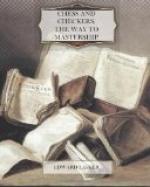PART I: THE GAME OF CHESS
I
THE RULES OF THE GAME
BOARD AND MEN
The game of Chess is played by two armies who oppose each other on a square board or battlefield of sixty-four alternate white and black squares. Each army has sixteen men; one King, one Queen, two Rooks (or Castles), two Bishops, two Knights and eight Pawns. The Generals of the two armies are the two players themselves. The men of one side are of light color and are called White, those of the other side are of dark color and are called Black.
The object of the game is to capture the opposing King. When this is done the battle is ended, the side losing whose King is captured. To understand what is meant by the capture of the King it is first necessary to become acquainted with the laws according to which the different men move on the board.
To start with, the board must be placed so that the players have a white square at their right. Then the men take the positions shown in Diagram 1.
The Rooks occupy the corner squares; next to them stand the Knights; then the Bishops and in the center the King and the Queen.
+---------------------------------------+ 8 | #R | #Kt| #B | #Q | #K | #B | #K | #R | |---------------------------------------| 7 | #P | #P | #P | #P | #P | #P | #P | #P | |---------------------------------------| 6 | | | | | | | | | |---------------------------------------| 5 | | | | | | | | | |---------------------------------------| 4 | | | | | | | | | |---------------------------------------| 3 | | | | | | | | | |---------------------------------------| 2 | ^P | ^P | ^P | ^P | ^P | ^P | ^P | ^P | |---------------------------------------| 1 | ^R | ^Kt| ^B | ^Q | ^K | ^B | ^Kt| ^R | +---------------------------------------+ a b c d e f g h
Diagram 1
The white Queen must be on the white square and the black Queen on the black square. These eight, men are commonly known as “pieces” in distinction from the Pawns. The latter occupy the line of squares immediately in front of the Pieces.
The lines of squares now occupied by the men and the other four vacant horizontal lines between them are called ranks. The vertical lines of squares running perpendicularly to the ranks are called files. The oblique lines of squares, that is, lines which connect squares of the same color, are called diagonals.
To describe the moves of the men on the board in a simple way it is necessary to indicate every square and every man by a short symbol. For this purpose different systems have been suggested at different times, but only two of them have been generally adopted. The older one, called the “descriptive notation,” still predominates in the English, French and Spanish speaking countries, but as leading English and American writers have lately used the newer “algebraic notation” which is much more simple, the latter will be employed in this book. Later the former method will be explained for the sake of completeness.




